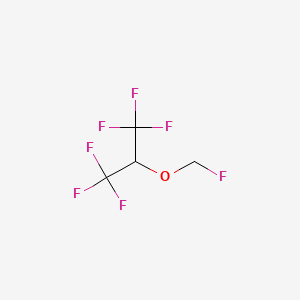Attribution Statement: LactMed is a registered trademark of the U.S. Department of Health and Human Services.
NCBI Bookshelf. A service of the National Library of Medicine, National Institutes of Health.
Drugs and Lactation Database (LactMed®) [Internet]. Bethesda (MD): National Institute of Child Health and Human Development; 2006-.
CASRN: 28523-86-6

Drug Levels and Effects
Summary of Use during Lactation
There is little published experience with sevoflurane during breastfeeding. Because the serum half-life of sevoflurane in the mother short and the drug is not expected to be absorbed by the infant, no waiting period or discarding of milk is required. Breastfeeding can be resumed as soon as the mother has recovered sufficiently from general anesthesia to nurse.[1] When a combination of anesthetic agents is used for a procedure, follow the recommendations for the most problematic medication used during the procedure. General anesthesia for cesarean section using sevoflurane as a component may delay the onset of lactation. In one study, breastfeeding before general anesthesia induction reduced requirements of sevoflurane and propofol compared to those of nursing mothers whose breastfeeding was withheld or nonnursing women.[2]
Drug Levels
Maternal Levels. Relevant published information was not found as of the revision date.
Infant Levels. Relevant published information was not found as of the revision date.
Effects in Breastfed Infants
Relevant published information was not found as of the revision date.
Effects on Lactation and Breastmilk
A randomized study compared the effects of cesarean section using general anesthesia, spinal anesthesia, or epidural anesthesia, to normal vaginal delivery on serum prolactin and oxytocin as well as time to initiation of lactation. General anesthesia was performed using propofol 2 mg/kg and rocuronium 0.6 mg/kg for induction, followed by sevoflurane and rocuronium 0.15 mg/kg as needed. After delivery, patients in all groups received an infusion of oxytocin 30 international units in 1 L of saline, and 0.2 mg of methylergonovine if they were not hypertensive. Fentanyl 1 to 1.5 mcg/kg was administered after delivery to the general anesthesia group. Patients in the general anesthesia group (n = 21) had higher post-procedure prolactin levels and a longer mean time to lactation initiation (25 hours) than in the other groups (10.8 to 11.8 hours). Postpartum oxytocin levels in the nonmedicated vaginal delivery group were higher than in the general and spinal anesthesia groups.[3]
A retrospective study of women in a Turkish hospital who underwent elective cesarean section deliveries compared women who received bupivacaine spinal anesthesia (n = 170) to women who received general anesthesia (n = 78) with propofol for induction, sevoflurane for maintenance and fentanyl after delivery. No differences in breastfeeding rates were seen between the groups at 1 hour and 24 hours postpartum. However, at 6 months postpartum, 67% of women in the general anesthesia group were still breastfeeding compared to 81% in the spinal anesthesia group, which was a statistically significant difference.[4]
References
- 1.
- Dalal PG, Bosak J, Berlin C. Safety of the breast-feeding infant after maternal anesthesia. Paediatr Anaesth. 2014;24:359–71. [PubMed: 24372776]
- 2.
- Bhaskara B, Dayananda VP, Kannan S, et al. Effect of breastfeeding on haemodynamics and consumption of propofol and sevoflurane: A state entropy guided comparative study. Indian J Anaesth. 2016;60:180–6. [PMC free article: PMC4800934] [PubMed: 27053781]
- 3.
- Kutlucan L, Seker IS, Demiraran Y, et al. Effects of different anesthesia protocols on lactation in the postpartum period. J Turk Ger Gynecol Assoc. 2014;15:233–8. [PMC free article: PMC4285212] [PubMed: 25584032]
- 4.
- Karasu D, Yilmaz C, Ozgunay SE, et al. A comparison of the effects of general anaesthesia and spinal anaesthesia on breastfeeding. C R Acad Bulg Sci. 2018;71:993–1000. [CrossRef]
Substance Identification
Substance Name
Sevoflurane
CAS Registry Number
28523-86-6
Disclaimer: Information presented in this database is not meant as a substitute for professional judgment. You should consult your healthcare provider for breastfeeding advice related to your particular situation. The U.S. government does not warrant or assume any liability or responsibility for the accuracy or completeness of the information on this Site.
- User and Medical Advice Disclaimer
- Drugs and Lactation Database (LactMed) - Record Format
- LactMed - Database Creation and Peer Review Process
- Fact Sheet. Drugs and Lactation Database (LactMed)
- Drugs and Lactation Database (LactMed) - Glossary
- LactMed Selected References
- Drugs and Lactation Database (LactMed) - About Dietary Supplements
- Breastfeeding Links
- PMCPubMed Central citations
- PubChem SubstanceRelated PubChem Substances
- PubMedLinks to PubMed
- Review Enflurane.[Drugs and Lactation Database (...]Review Enflurane.. Drugs and Lactation Database (LactMed®). 2006
- Review Isoflurane.[Drugs and Lactation Database (...]Review Isoflurane.. Drugs and Lactation Database (LactMed®). 2006
- Review Desflurane.[Drugs and Lactation Database (...]Review Desflurane.. Drugs and Lactation Database (LactMed®). 2006
- Review Propofol.[Drugs and Lactation Database (...]Review Propofol.. Drugs and Lactation Database (LactMed®). 2006
- Review Fospropofol.[Drugs and Lactation Database (...]Review Fospropofol.. Drugs and Lactation Database (LactMed®). 2006
- Sevoflurane - Drugs and Lactation Database (LactMed®)Sevoflurane - Drugs and Lactation Database (LactMed®)
Your browsing activity is empty.
Activity recording is turned off.
See more...
